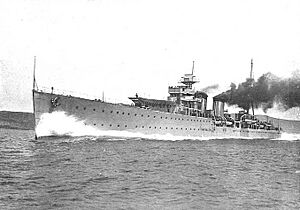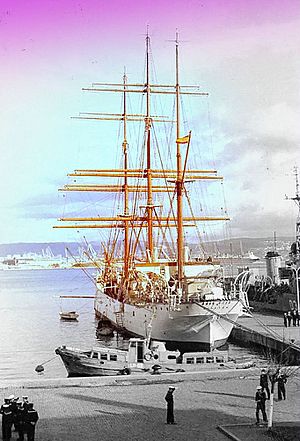Luis de la Sierra facts for kids
Quick facts for kids
Luis de la Sierra
|
|
|---|---|
| Born |
Luis de la Sierra Fernández
1920 Santander, Spain
|
| Died | October 11, 2016 (aged 95–96) Palma de Mallorca, Spain
|
| Nationality | Spanish |
| Alma mater | Escuela Naval Militar |
| Occupation | Historian, writer and military personnel |
Luis de la Sierra Fernández (born in Santander, Spain, in 1920 – died in Palma de Mallorca, Spain, on October 11, 2014) was a Spanish writer, historian, and sailor. He was famous for his books about naval history and his travel adventures.
Contents
A Sailor's Life
When Luis de la Sierra was 17, during the Spanish Civil War, he joined the Spanish Navy. He served on a light cruiser called the Almirante Cervera.
After the war, he went to the Escuela Naval Militar (Military Navy School) in San Fernando, Cádiz. In 1943, he became an alférez de navío, which is like an ensign or a junior officer in the navy.
He became an expert in submarine warfare and Torpedoes. During his long career, he worked on many different ships. These included minelayers, cruisers, and even school ships like the Galatea and the Juan Sebastián Elcano.
He finished his military career teaching at the Submarine Arms School. He taught there until 1982.
A Writer's Journey
Luis de la Sierra's first book was called "Buques suicidas" (Suicide Ships). It was about small submarines, human torpedoes, and explosive boats from the 20th century. The Spanish Navy published it, and it won a special award in 1963.
This book's success helped him start his writing career. He mainly wrote books about naval history, especially about sea battles in both World Wars. He also wrote travel books and guides. He even translated books by other international authors into Spanish.
To do his research for his books, he often traveled. He visited many cities in Spain, like Almería, Barcelona, Cádiz, Cartagena, Madrid, Palma de Mallorca, and Santander.
His Books
Many of Luis de la Sierra's books have not yet been translated into English. So, their original Spanish titles are listed here.
- Buques suicidas (Suicide Ships) (1958)
- Titanes azules (Blue Titans) (1963)
- Corsarios alemanes en la Segunda Guerra Mundial (German Raiders in World War II) (1969)
- La guerra naval en el Atlántico (1939–1945) (Naval War in the Atlantic) (1974)
- La guerra naval en el Mediterráneo (1940–1943) (Naval War in the Mediterranean) (1976)
- La guerra naval en el Pacífico (1940–1943) (Naval War in the Pacific) (1979)
- El mar en la Gran Guerra (1914–1918) (The Sea in the Great War) (1984)
- Corsarios alemanes en la gran guerra (1914–1918) (German Raiders in the Great War) (1985)
Travel Books
- Viajes de un marino (A Sailor's Travels) (1981)
- Viaje a Egipto (Journey to Egypt) (1990)
- Viaje a Mesoamérica (Journey to Mesoamerica) (1991)
- Viaje a la India (Journey to India) (1993)
- Viaje a China (Journey to China) (1995)
- Viaje a la Atlántida (Journey to Atlantis) (2003)
- Mis viajes (My Travels) (2004)
Translated Books
Luis de la Sierra also translated books by famous authors into Spanish:
- El acorazado "Bismarck" (The Battleship Bismarck) by Burkard von Müllenheim-Rechberg (1982)
- Expedición (Expedition) by Thor Heyerdahl (1972)
- Las expediciones Ra (The Ra Expeditions) by Thor Heyerdahl (1973)
- La expedición Tigris (The Tigris Expedition) by Thor Heyerdahl (1981)
- Navegando en solitario alrededor del mundo (Sailing Alone Around the World) by Joshua Slocum (1981)
- El misterio de las Maldivas (The Maldives Mystery) by Thor Heyerdahl (1986)
- Tifón, el otro enemigo (Typhoon, the Other Enemy) by Raymond C. Calhoun (1986)
- La vuelta al mundo del Gipsy Moth (Gipsy Moth Around the World) by Francis Chichester (1993)
See also
 In Spanish: Luis de la Sierra para niños
In Spanish: Luis de la Sierra para niños



